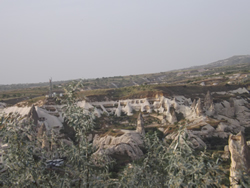
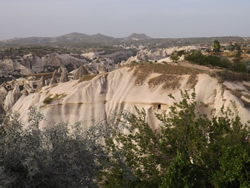
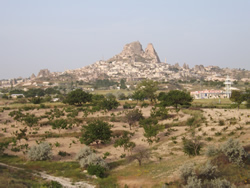
|
Any comments or questions please contact us: kevin@sailawayonline.co.uk or ann@sailawayonline.co.uk (Please note our reply depends on available internet access, we will reply to you as soon as possible.) |
VIII - Eventually we reach Turkey, Kas and Sailaway!
To view our previous log entries please use the following link:
VII - The drive through Serbia and Bulgaria.
To view our next log entries please use the following link:
Log Entry Wednesday 30th May - With another early start we make the 500 mile (13 hour) trip to Kas and Sailaway in one jump!
 |
 |
 |
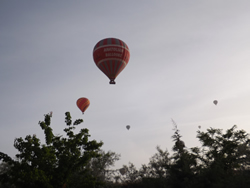 |
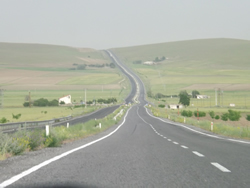 |
We wake about 0530 hours, a long way to go today we are both looking forward to seeing Sailaway again - over nine and a half months since we left her. The past seven weeks on the road has been a wonderful experience, but, "home is home!" The good thing is that at this time of the morning the roads are extremely quiet.
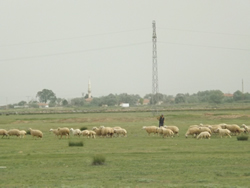 |
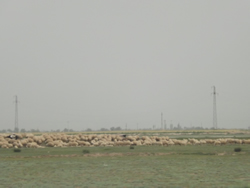 |
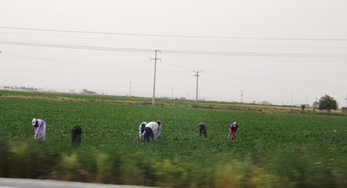 |
There is however, already plenty of work going on the land already, live stock is always "watched", crops are already being picked.
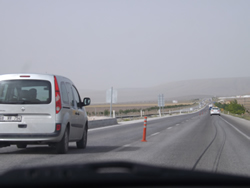 |
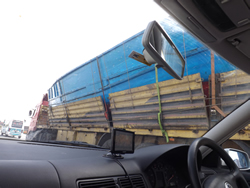 |
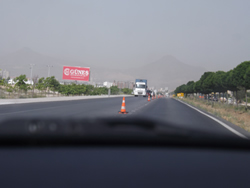 |
It appears that the Turkish Government are spending millions/billions of cash into the road infrastructure, it is not long before we are again in sections of road improvements. Of coarse, by now I am completely accustomed to the Turkish way of driving - over taking through traffic cones is quite acceptable here.
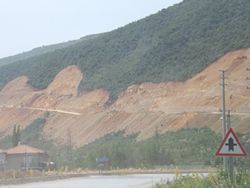 |
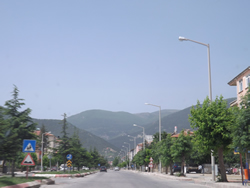 |
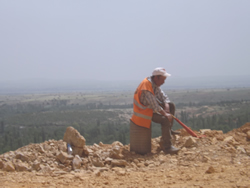 |
We then come across one of those experiences in life one never forgets, in the distance it is clear there are major road improvements ahead, cutting a new carriage way through the mountains to Altanya. We come to the control of the traffic at the start of the work, not unusual to have men controlling the traffic with flags - this guy was however asleep? I was concerned about disturbing him to ask if we could go forward as he was balanced on what looked to be the very edge of a shear drop, so we left him and drove cautiously on.
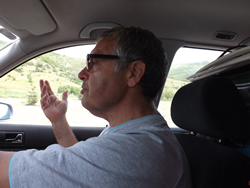 |
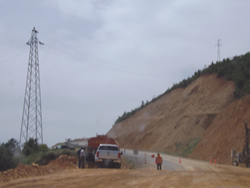 |
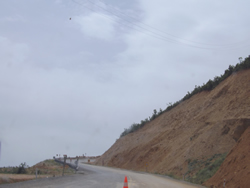 |
Of coarse, by now I even have the correct Turkish hand gestures to deal with appropriate situations you come across on the road - Ann laughs!
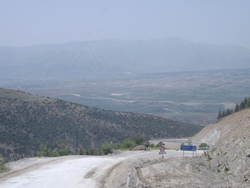 |
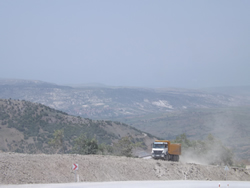 |
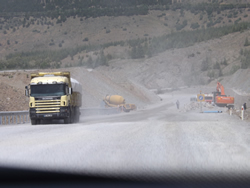 |
We spend the next couple of hours driving around the workers and construction traffic, work ongoing every where.
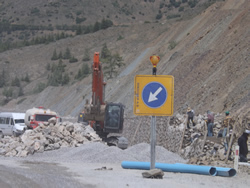 |
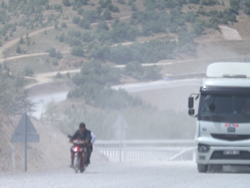 |
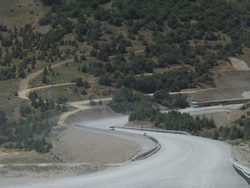 |
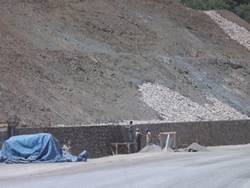 |
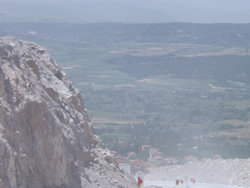 |
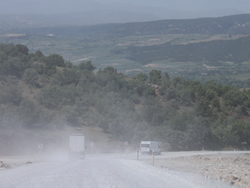 |
The dirt and dust every where, we worked on the same principle as one does at sea, "if it is bigger and noisier than you, give it right of way!"
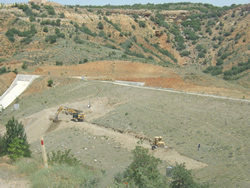 |
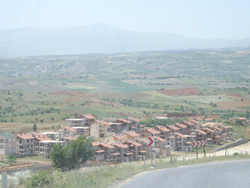 |
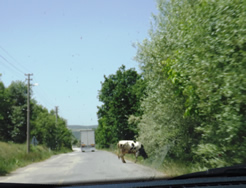 |
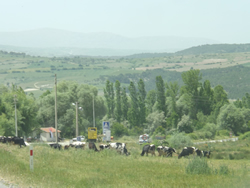 |
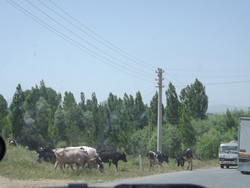 |
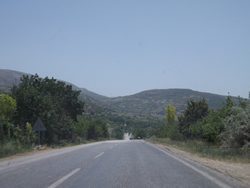 |
The road construction disappeared and quickly as it had begun, different sorts of issues to deal with now?
 |
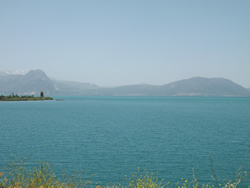 |
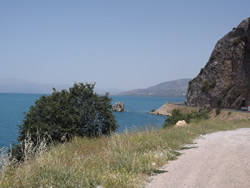 |
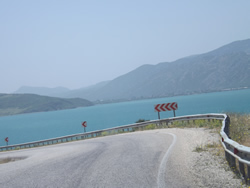 |
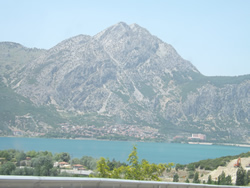 |
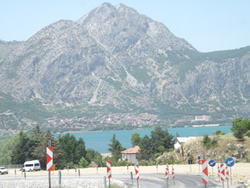 |
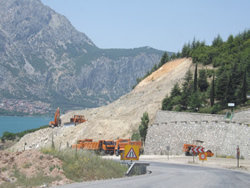 |
The scenery never stopped changing, making our slow progress more interesting, and of coarse plenty more roadwork's to negotiate.
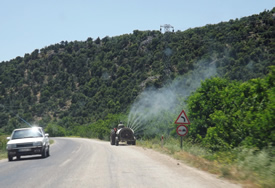 |
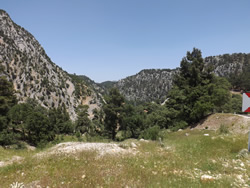 |
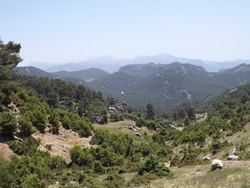 |
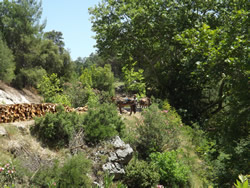 |
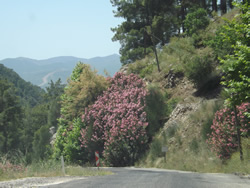 |
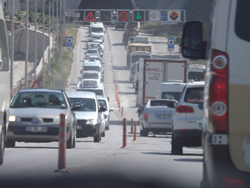 |
We made our way towards Altanya, and, along with any major city comes it's traffic and of coarse "roadwork's".
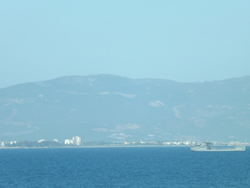 |
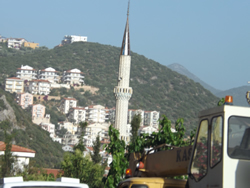 |
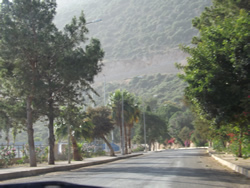 |
We skirted around the city and in time got our first glimpse of the sea, our route was now to follow the coast south and west eventually arriving in Kas, some 500 miles and 13 hours later - good to be home to Sailaway. It was now to be a couple of days rest to recover from the seven week trip, then Sailaway is due to be lifted out and maintained - almost three years since her last fit out.
Log Entry Tuesday 29th May - With an early start we spend a wonderful day in the Göreme area. then decide to make the 500 mile (13 hour) trip to Kas and Sailaway in one jump!
 |
 |
 |
We were awake early, the heat helps - we had been told of the balloon trips early each morning, we were keen to see what one could get for between €100/€170 per person as we were quoted! We leave the site around 0530 and make our way the short distance to the plateau over looking Göreme.
 |
 |
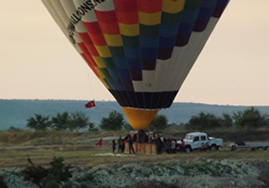 |
The ballooning activity had just began, we at first made out a couple of balloons being inflated across the valley from us, then they began to appear all around us in all directions. How they pick their launch area, who knows, some must have the slight wind in their favour, some not?
 |
 |
 |
 |
 |
 |
Soon the skies appear full of hot air balloons, moving off in all directions - their baskets varying in size, but hundreds of people must have been carried ,certainly today!
 |
 |
 |
 |
The balloons across the valley took a slightly different route, looking to almost disappear down into the streets of Göreme? We followed them down, but by car!
 |
 |
 |
 |
The town of Göreme, is a real mix of the old and new, grown to support the active, growing, tourist trade and the visitors.
 |
 |
 |
A lot of the chimneys still occupied in one way or another, some even under renovation.
 |
 |
 |
 |
From the town we drove into the "Dervent Valley" to see more of the chimney landscape, on some of the tops on the chimneys sit rocks of a harder material weathered less than the tufa below it.
 |
 |
 |
The landscape had obviously changed many times over the centuries, we even found one "old boy" living far from and road - still clearly quite happy with his home?
We visit The Tokali Church (circa. 10th Century) just outside Göreme, believed to be the oldest known rock-cut church in the region. The single naved, barrel vaulted church was originally constructed in the 10th century, the life of Jesus told in fresco form on separate panels on the vault from left to right.
 |
 |
 |
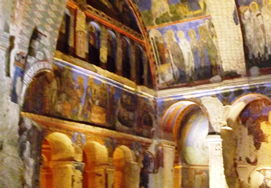 |
Scenes display the saints, annunciation, visitation, proof of the virgin, and the journey to Bethlehem and Nativity, then, onto the betrayal, crucifixion etc. - restoration is ongoing. It is to our surprise to what magnitude Christianity existed here in these early times?
Our final visit of the day was to one of the many prehistoric under ground settlements in the Cappadocia regions, over time into the middle and late Bronze Age complete settlements/small towns existed underground. It is believed that the Roman era played a role in the construction of these civilisations. Items found in these settlements date from the Byzantine Period (5th - 10th Century) they were often used to take refuge for religious reasons.
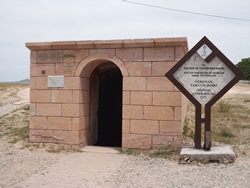 |
We visit the underground settlement in Özkonak, 14km north of Avanos, the settlement hollowed out of the tufa rock on the western slopes of Idis Dagi. This settlement constructed on three levels and serviced by a fresh water supply below the lower level. The detail in design of these settlements is quite advanced, air quality is excellant, multiple levels serviced with interconnecting tunnels.
 |
 |
 |
 |
 |
 |
It is hard to image civilisations existing like this, at times with all food supplies and animal stock held down below too.
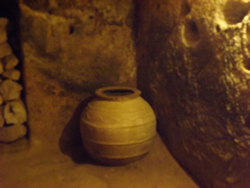 |
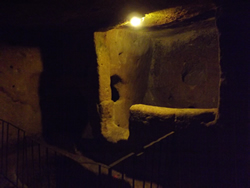 |
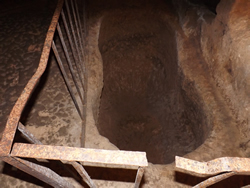 |
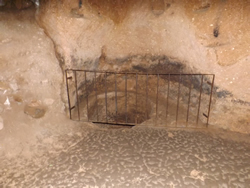 |
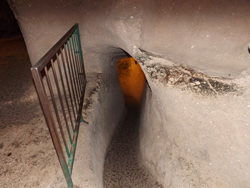 |
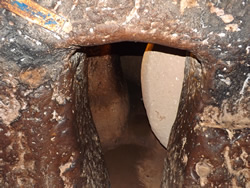 |
The tunnel ways are reflective of the humans size at that time, small in height and barely impossible to turn around in the corridors.
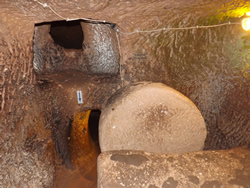 |
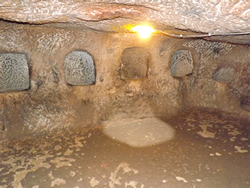 |
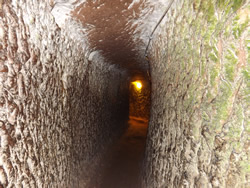 |
The dwelling was completely self supporting and defendable, large circular boulders carved in situ were used to seal entrances, moved by a series of counter weights.
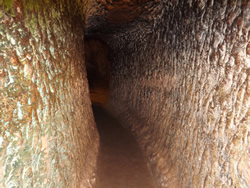 |
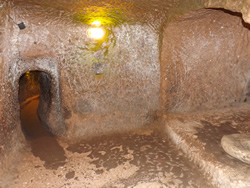 |
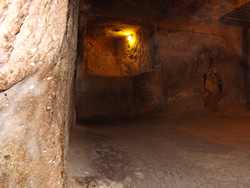 |
The halls in which the livestock were held are significantly larger than the living quarters of the humans, this was one of the small settlements but said to be one of the better examples with good lighting and air quality.
 |
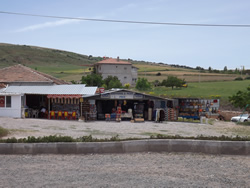 |
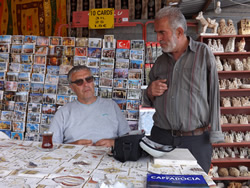 |
The settlement was originally discovered by a gentleman called "Latif Acer" in 1972, in his garden. We were lucky enough to meet him and have a very interesting conversation with him about his findings. As the concern and tourist industry grew, the ownership was taken over by the Government, he continues his support and compliments the site with his cafe and shop.
Log Entry Monday 28th May - We arrive at Göreme, Cappadocia.
We rise fairly early and spend some time with a fellow resident "Hans" although working here in Ankara he has visited Cappadocia and is able to provide us with much valued information. In time we bid our farewells and again head south east again towards Aksaray, passing lake Tuz Gölü, then turning north east to Göreme. A trip of less than 180 miles but much slower progress due to various road sections - a trip of about 5 hours!
 |
 |
 |
The road section to Tuz Gölü is good as is our time made, heaven knows what road lies ahead to loose us so much time?
 |
 |
 |
 |
 |
Tuz Gölü is effectively a salt lake, it is said to hold healing properties within it's salts, used for centuries, quite a small to medium industry exists around it.
 |
 |
 |
Once back on the road it then becomes apparent as to what type of delays lie ahead to slow our progress down - road works. The single lane road was being converted into dual carriageway as we drove on it! Whole towns had their high streets widened, clearly the residents had not yet become accustomed to the changes as for all there were bridges constructed over the new, wider sections they would insist on crossing directly. This meant they were negotiating both road and construction traffic, still, gave another form of challenge to the drive, the construction seemed to be going on forever!
 |
 |
 |
I soon became accustomed to a new way of driving through road construction traffic as "over taking" seemed quite acceptable here the additional challenge being to dodge the centre cones as you moved from side to side! As our steering wheel is on the kerb side here Ann had to give the the "OK" to pull out and drive through the cones - what team work!
 |
 |
 |
The road winds on, it's surface worsening in time and as a result our average speed falls, Cappadocia approaches.
Cappadocia is the area covered by the city provence's of Uçhisar, Göreme, Avanos, Ürgüp, Derinkuyu, Kaymakli and Ihlara. Today the whole area's current state is the result of volcanic activity, circa. 10 million years ago. The lava produced by the volcanoes, Mt Erciyes, Hasandag and Göllüdag to name but a few, under the Neo-gen lakes of that time formed a layer of "tufa" on the area's plateaus varying in thickness between 100 - 150 metres. The development of various rivers and other erosion from weather etc brought about a continuous change in the landscape bring about it's present day's form.
 |
 |
 |
It visually becomes very clear from the dramatic change in terrain that you are actually in the Cappadocia Region.
 |
 |
 |
 |
The soft "tufa" in time was utilised as a form of dwellings and storage, easily carved out with the tools of that time, dating back to the 6th Century. The formation of the "Fairy Chimneys" a conical formation from wind and flood water in the Uçhisar, Ürgüp and Avanos regions were easily utilised and soon small civilisations developed and grew, some still utilised today - an area of great interest.
 |
 |
 |
Today it is a key focus for the tourists and all that particular industry brings.
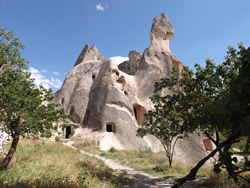 |
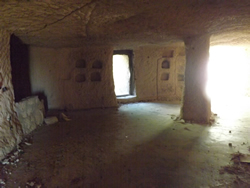 |
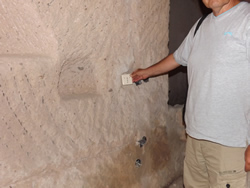 |
We had a wander around an abandoned dwelling, an ex-hotel from nearby signs - complete with mains electric!
 |
 |
 |
The whole area is of interest, as one scans the horizon a different view is seen each time. The "lived in chimneys" took the form of cafes, hotels gift shops etc.
 |
 |
 |
 |
We eventually arrive and check into a terraced style campsite, recommended by people we had previously met, excellant views over Göreme, a town of great mix between the old and the new.
Log Entry Sunday 27th May - Now en route for Cappadocia we decide to split the 500 mile trip southeast into two sections.
We re-pack our car and get underway, we put the condition of our room and lack of compensation other than a free 2TL bottle of water from the mini bar, down to "another of one's life experiences!"
 |
 |
 |
We make our way south east towards Ankara, we have a planned over night stop at a campsite, a part of a hotel complex - pool and all! The roads are good, it has been some time since we were able to average 60mph, and in this case our speed restricted by ourselves.
 |
 |
 |
 |
 |
 |
We soon pass by Ankara, we have no interest in the large city other than it is "on our way!" In less than an hour later we arrive at the hotel near Gölbasi, on the shores of lake "Morgan Gölü", register and pitch our tent for the evening.
 |
 |
 |
 |
 |
The site is quite compact but along with the hotel facilities it has more than we need, we give the gym a miss?
 |
 |
The local area is very rural, farms, men watching their stock, the lake provides it's own entertainment, some form of large birds soar above the reeds, I am unable to identify them - too far off?
Log Entry Saturday 26th May - We pack up early and head for the Turkish boarder.
We bid our farewells to the proprietor and his assistant and leave for the Turkish boarder, there is clearly no change in the road quality so the 50 miles takes about an hour and a half! We approach the Bulgarian boarder on a narrow single carriage road of poor quality, pass through "no mans land" as I call it and then on the Turkish side and enter what must be a 10 gate processing line, all but two gates open. If the Bulgarian side was lined solid with traffic bumper to bumper they could not get enough vehicles through to utilise this number of gates? Once through the first gate you move through again passport control, a large duty free (airport style commercial/service centre) then through customs. The service centre allowed us to buy the required vehicle insurance as we had no "green card" (@ €144/6 months) very quickly and move on to Customs. Again, only a couple of words were spoken on our visit and we were pushed on, the car being stamped into my passport. In Turkey the car can only stay for a maximum of 6 months, I was registered as coming in by car, I have to therefore leave by car! We have to pay a further tax of 50TL (£22) for the privilege of using their roads just like most of the other countries we have passed through - look at the revenue the UK are loosing that could be spent on the road upkeep?
Our clearance over the boarder is far simpler and faster than we could ever imagined, it is now our plan to cross Istanbul and make for the town of Esentepe, in the Sakarya district, then on to Cappadocia.
 |
 |
 |
It was now quite clear we were in Turkey, the backlog of trucks to be cleared was enormous, the hold up on the Bulgarian side, unable to process the traffic pouring in at them via this modern, well maintained road system, the stationary line of trucks went on for miles. This was clearly a normal situation as people were selling food and drinks from barrows along the roadside?
 |
 |
 |
 |
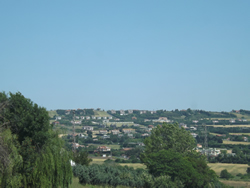 |
 |
We were now able to maintain a good speed on good quality road surfaces, the drive through this very green, arable Turkey was very different to the Turkish terrain we were used too! On the coastline we were used to seeing rock, boulders etc - this land was green!
 |
 |
 |
 |
 |
 |
We were soon to hit and cross Istanbul, what a crazy place to drive, very busy road sections at times of four lanes or more and we were still being "under taken" by speeding cars on the hard shoulder, what an experience?
After some time we reached our campsite at Esentepe - or not, it was not there! It had been converted into part of a University complex, we knew of no other sites around the area, not a common occurrence in this region so we were forced into a hotel. The hotel was interesting, very extravagant and impressive to look at but very little worked inside - it reminded me of the hotels I frequented in China twenty years ago? Still, we had to unload the car, the evening, what was left of it passed very quickly. When we checked in they spoke great English when I complained in the morning they seemed to loose the ability to speak English - pack the car and move on! Perhaps why they had insisted on payment up front for the room?